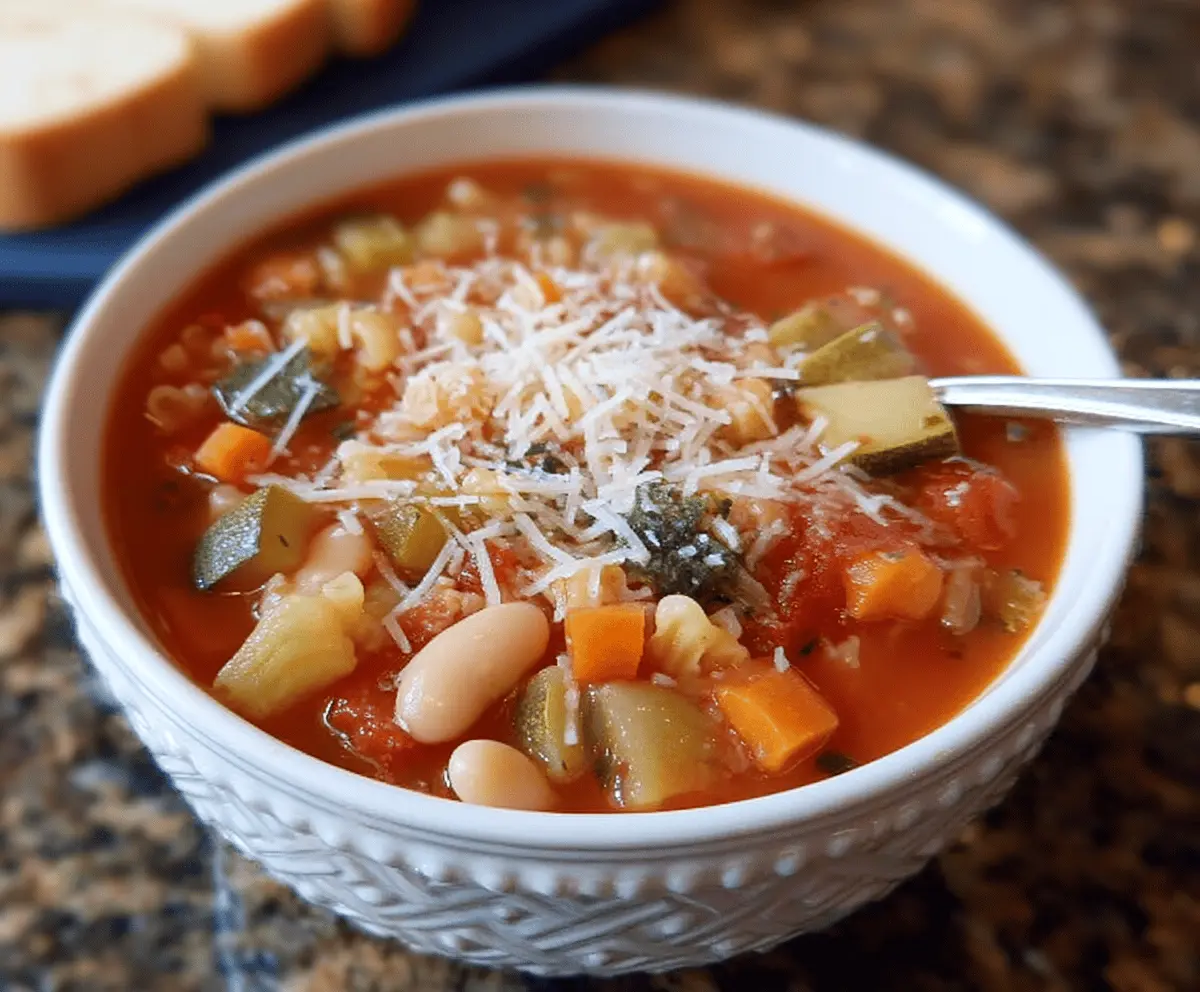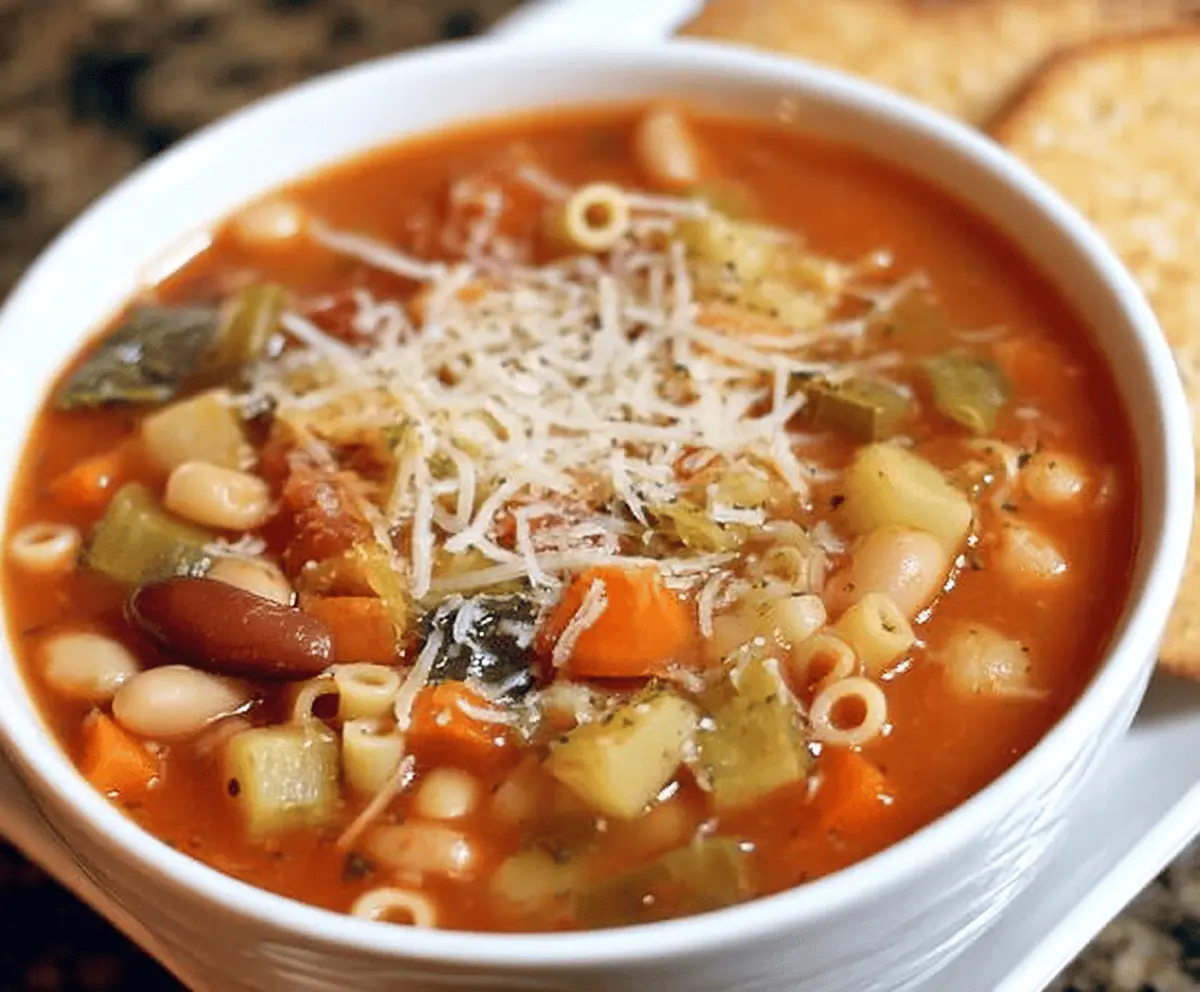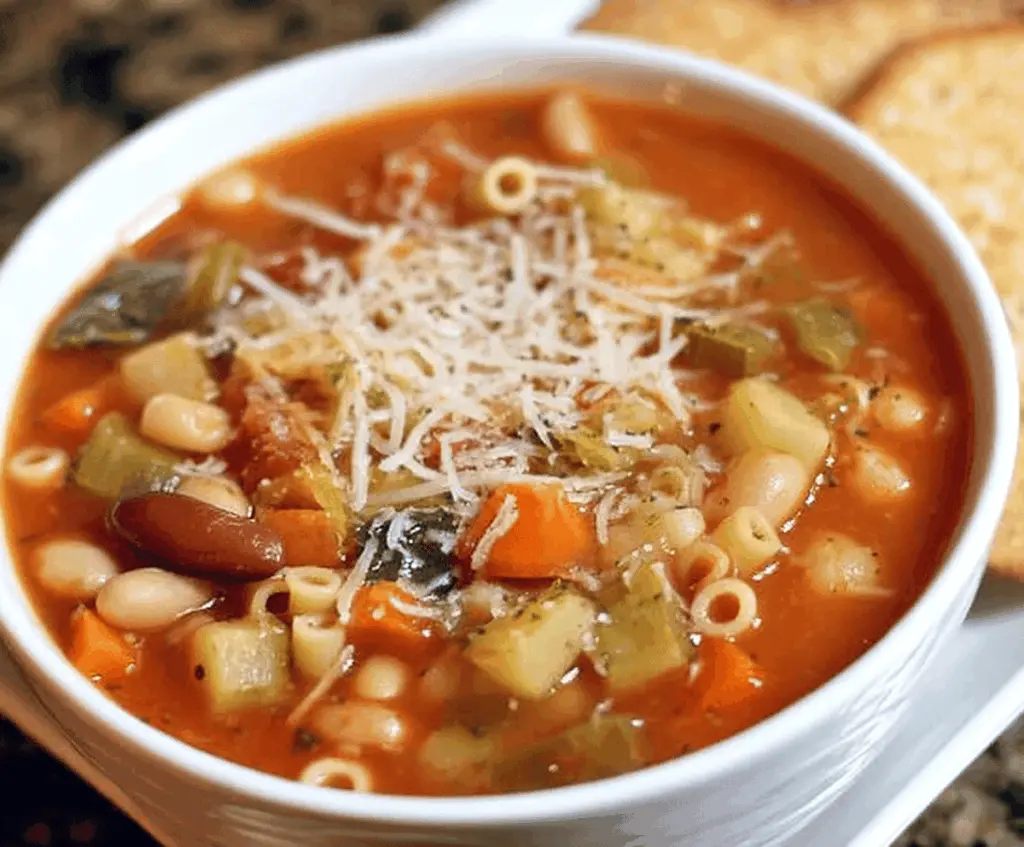Classic Minestrone Soup is a hearty mix of tender vegetables, beans, pasta, and a rich tomato broth that warms you up from the inside out. It’s packed with garden-fresh flavors like zucchini, carrots, celery, and green beans, making it colorful and comforting all at once. The combination of beans and pasta adds just the right amount of texture and heartiness without being too heavy.
I love making this soup when I want something healthy but satisfying. It’s one of those recipes where you can easily toss in whatever veggies you have on hand, so it’s super flexible. I usually add a good handful of fresh herbs at the end to boost the flavor, which always makes the soup taste a little brighter and fresher.
My favorite way to enjoy Classic Minestrone Soup is with a piece of crusty bread for dipping and a sprinkle of Parmesan cheese on top. It’s perfect for a cozy night in or even a simple lunch. Every spoonful feels like a warm hug, which is why this soup always feels like home to me.
Key Ingredients & Substitutions
Olive oil: It’s the flavor base here. Use extra virgin for the best taste. If you need a neutral oil, sunflower or canola work fine, but you’ll miss a little richness.
Beans: Cannellini beans add creaminess and protein. You can swap for kidney beans, chickpeas, or any white bean you like.
Small pasta: Ditalini is classic, but small elbow macaroni or even broken spaghetti are good substitutes. Consider gluten-free pasta if needed.
Vegetables: Zucchini, carrots, celery, and green beans provide texture and color. Feel free to add seasonal veggies like peas, spinach, or kale for extra greens.
Herbs: Dried oregano, basil, and thyme are traditional. Fresh herbs at the end brighten the soup—add them to your taste!
How Can You Make the Vegetables Tender but Not Mushy?
Getting the perfect texture means cooking your vegetables carefully. Here’s how I do it:
- Sauté the onion and garlic first to build flavor without overcooking.
- Add root veggies like carrots and celery early—they take longer to soften.
- Add quicker-cooking veggies like zucchini and green beans later to keep some bite.
- Simmer the broth and tomatoes to let flavors meld but keep everything a bit firm.
- Add pasta and beans last to avoid mushiness; cook until pasta is just tender.
This layering lets each vegetable shine without turning into a mushy soup. I like a mix of tender and slightly firm veggies for texture contrast.

Equipment You’ll Need
- Large pot – I recommend a deep one to hold all the soup and let it simmer evenly.
- Wooden spoon or ladle – for stirring and serving without scratching your pot.
- Chopping board and knife – for chopping all the vegetables easily and safely.
- Measuring cups and spoons – to get the right amount of broth, pasta, and herbs.
- Grater (optional) – if you want to grate fresh Parmesan directly onto the soup.
Flavor Variations & Add-Ins
- Swap beans: Use chickpeas or kidney beans if you prefer a different flavor or texture.
- Add protein: Stir in cooked sausage, shredded chicken, or bacon for extra heartiness.
- Use different greens: Kale, spinach, or Swiss chard all work well to add different textures and flavors.
- Change herbs: Fresh rosemary or thyme can give a new aromatic twist to the soup.

How to Make Classic Minestrone Soup
Ingredients You’ll Need:
Vegetables & Beans:
- 2 tablespoons olive oil
- 1 medium onion, diced
- 2 cloves garlic, minced
- 2 medium carrots, diced
- 2 stalks celery, diced
- 1 medium zucchini, diced
- 1 cup green beans, cut into 1-inch pieces
- 1 can (14.5 oz) diced tomatoes
- 1 can (15 oz) cannellini beans or white beans, drained and rinsed
- 2 cups chopped spinach or kale (optional)
Liquids & Seasonings:
- 6 cups vegetable broth
- 1 teaspoon dried oregano
- 1 teaspoon dried basil
- ½ teaspoon dried thyme
- Salt and freshly ground black pepper, to taste
Other:
- ½ cup small pasta (such as ditalini or small elbow macaroni)
- ¼ cup freshly grated Parmesan cheese (for garnish)
- Fresh parsley or basil, chopped (optional, for garnish)
How Much Time Will You Need?
Preparing and cooking this soup takes about 45 minutes. Most time is spent simmering the vegetables and pasta to develop rich flavors and tender textures.
Step-by-Step Instructions:
1. Sauté the Aromatics:
Heat olive oil in a large pot over medium heat. Add the diced onion and cook until translucent, about 3 to 4 minutes. Stir in the minced garlic and cook for 1 minute until fragrant.
2. Cook the Vegetables:
Add diced carrots and celery to the pot. Stir and cook for 5 minutes, letting them soften. Then add the diced zucchini and green beans, stirring to combine everything.
3. Build the Soup Base:
Pour in the diced tomatoes with their juices and the vegetable broth. Sprinkle in the dried oregano, dried basil, dried thyme, salt, and pepper. Bring the soup to a boil, then reduce the heat and simmer uncovered for about 20 minutes until the vegetables are tender.
4. Add Pasta and Beans:
Stir in the small pasta and the drained beans. Cook for another 10 minutes or until the pasta is al dente (tender but still slightly firm).
5. Add Greens and Finish:
If using, add chopped spinach or kale and cook for 2 to 3 minutes until they wilt. Taste the soup and adjust salt and pepper if needed.
6. Serve and Garnish:
Ladle the hot soup into bowls. Sprinkle freshly grated Parmesan cheese over the top and garnish with chopped fresh parsley or basil if you like. Serve warm with crusty bread for a perfect meal.
Can I Use Frozen Vegetables in Minestrone Soup?
Yes! Frozen veggies work well and save prep time. Just add them when you would fresh ones and adjust cooking time slightly to ensure they’re heated through but not mushy.
How Can I Make Minestrone Soup Gluten-Free?
Simply swap the small pasta for gluten-free pasta or omit it altogether. You can also use extra beans or add extra veggies to keep the soup hearty.
Can I Prepare Minestrone Soup Ahead of Time?
Absolutely! Make the soup a day in advance and store it in the fridge. Reheat gently on the stovetop, adding a little broth or water if it thickens too much.
How Should I Store Leftovers?
Keep leftovers in an airtight container in the fridge for 3-4 days. This soup also freezes well—just thaw in the fridge overnight and reheat gently on the stove.



